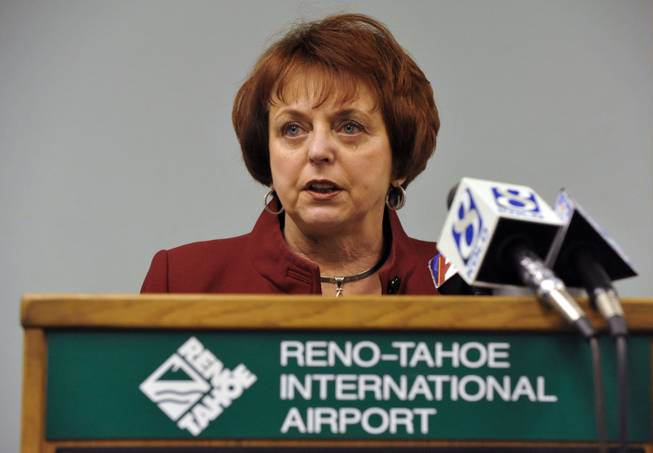
AP Photo/The Gazette-Journal, Tim Dunn
Krys T. Bart, president/CEO for the Reno-Tahoe Airport Authority, talks to the media Wednesday, April 13, 2011, at the airport about reports that the airport’s only air traffic controller fell asleep about 2 a.m. Wednesday while a medical aircraft was attempting to land. The plane landed safely without assistance from the tower, which is administered to by the Federal Aviation Administration and not the airport.
Published Wednesday, April 13, 2011 | 10:08 a.m.
Updated Thursday, April 14, 2011 | 12:30 a.m.
Audio of the call
The staffing crisis in the nation’s airport control towers was put on stark display Wednesday at the Reno-Tahoe International Airport, when an air ambulance pilot circled for 16 minutes trying to awaken the sleeping air traffic controller and finally had to land without the controller’s assistance.
In the past few years, several studies have documented how air traffic controllers are overworked, stressed and understaffed. More than half of the air traffic controllers in the country will be forced to retire during this decade, and there are not enough people in the pipeline to replace them.
No one was injured Wednesday, but the Federal Aviation Administration said it had suspended the air traffic controller for falling asleep at work and being out of communication. It happened about 2 a.m., when the circling aircraft, transporting a sick passenger and trying to contact the control tower seven times, made an unassisted landing.
The suspension is the second this month for the FAA, which has investigated at least five lapses this year in airports across the country — four involving controllers falling asleep on the job. The agency announced Wednesday it was immediately putting a second controller on the midnight shift at 27 airports across the country.
“I am totally outraged by these incidents. This is absolutely unacceptable,” Transportation Secretary Ray LaHood said in a statement. “The American public trusts us to run a safe system. Safety is our No. 1 priority and I am committed to working 24/7 until these problems are corrected.”
Although the controller’s suspension is a disciplinary action, airport chief Krys Bart indicated that blame didn’t just rest with the sleeping official, but with the system that left the airport and its runways in one person’s hands.
“The flying public needs an assurance from the FAA that this situation will be addressed at all airports,” Bart said. “We must have adequate staffing.”
Although LaHood’s quick response to the cry for help coming from airports such as Reno-Tahoe was applauded, his direction to amp up staffing may not be enough to address a deeper problem in the air traffic control force.
Air safety isn’t the easiest career to get into. Controllers are responsible not just for negotiating runway traffic, but policing the skies for about a 50-mile radius around their towers. It’s a high-stress position that requires eagle-eye attention on the job, which is difficult for anyone to keep up for an eight-hour shift; and many air traffic control units work rotating shifts to keep airports staffed around the clock.
To be hired, candidates must be no more than 31 years old and have begun the three-to-five year training to become certified. The federal government mandates that controllers retire by age 56.
Although air traffic controllers are considered “essential” national personnel, as we learned in the run-up to a potential government shutdown last week, Congress hasn’t yet addressed the problem.
Aviation safety was a major focus of the FAA reauthorization bill that the Senate passed in February 87-8. Nevada Sens. Harry Reid and John Ensign voted in favor of the legislation.
But the House passed a different version of the bill, one that funds the agency at about $4 billion less.
That may sound good in a time of deficit reduction — and the House bill contained an instruction not to let the cuts compromise aviation safety — but FAA officials have warned that bill would force them to furlough several hundred safety employees.
“It’s dangerous. It doesn’t protect passengers, it imperils passengers,” Reid said of the House’s bill.
It passed by a vote of 223-196, with Nevada Republicans Dean Heller and Joe Heck voting for it, and Democrat Shelley Berkley voting against it.
The two versions are going through the conferencing process, where their dissimilar provisions will be resolved before each chamber will be asked to OK the revised version.
Reid, who flies in and out of Reno several times a year, took a moment on the Senate floor to marvel that no one was injured in Wednesday’s incident, especially given what he called the “terribly rough” air conditions at the Reno-Tahoe airport as a result of winds off the Sierra Nevada nearby.
He urged congressional conferees, when considering the reauthorizations to modernize the country’s aviation system, to fulfill what he called Congress’ “key role” in correcting the inadequacies of airport safety precautions as well.
“Last night’s near tragedy reminds us that the state-of-the-art structures and the best tech works only as well as the people operating them,” Reid said.
The Associated Press contributed to this report.


Join the Discussion:
Check this out for a full explanation of our conversion to the LiveFyre commenting system and instructions on how to sign up for an account.
Full comments policy